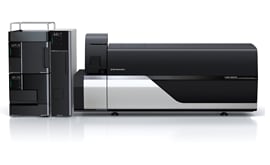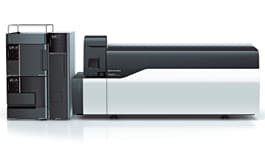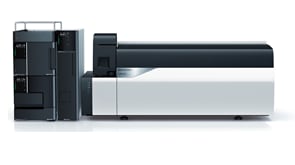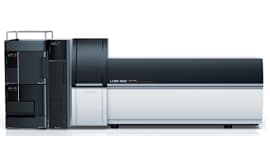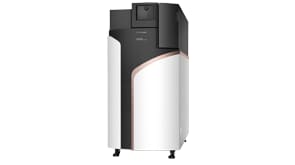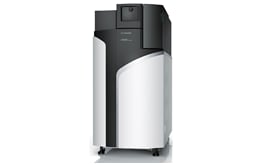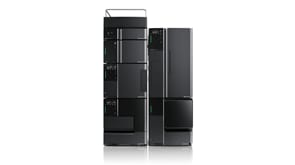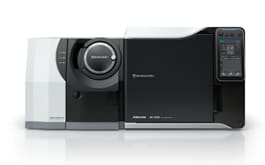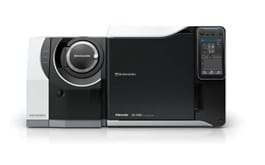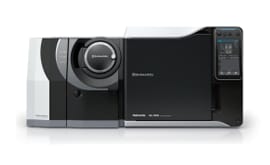Measuring Molecules Based on Weight—Mass Spectrometry Technology
All molecules contained in substances have a specific mass (molecular weight). Mass spectrometry technology can accurately identify and quantify molecules in a substance by separating and measuring each molecule based on differences in their mass. Its sensitivity is high enough to detect even a single grain of salt in a 25 m swimming pool. It has become an essential technology for many applications, such as identifying the causes of disease, developing new therapeutic drugs, and detecting residual pesticides in foods.
New Potential Applications for Mass Spectrometry Using Shimadzu’s Proprietary Ultra-Fast UF Technologies
The UF Technologies brand uses the acronym “UF” for “ultra-fast” and designates unique technologies available only from Shimadzu that can achieve impressively high speed and sensitivity levels. Consequently, UF Technologies can significantly improve the core functionality of mass spectrometry.
1. Simultaneous Analysis of Several Hundred Target Compounds
One characteristic of Shimadzu mass spectrometers is the ability to analyze samples extremely quickly. That means several hundred target compounds can be analyzed simultaneously with a single analysis in a chromatograph-mass spectrometer system. For example, it can simultaneously analyze metabolites formed by biological reactions in biological samples (metabolomics) or screen for residual pesticides and toxicological drugs in foods in a single analysis.
(Reference: LC/MS/MS Method Package for Primary Metabolites and LC/MS/MS Method Package for Residual Pesticides)

<MRM Chromatogram from Simultaneous Analysis of Standard Mixture Sample with 141 Compounds>
2. High-Speed Data Sampling Improves Quantitative Accuracy and Reproducibility
Extremely fast mass spectrometer speeds can also affect the accuracy (quantitative accuracy) and reproducibility of measuring the concentration of specific compounds in samples. Faster speed means time-dependent data for quantitative analysis can be measured at shorter sampling intervals, which improves quantitative accuracy and reproducibility by measuring signal peaks with more precision. Consequently, they are widely used for applications that require accurate quantitative analysis, such as measuring the content of compounds in pharmaceuticals in the pharmaceutical industry or measuring the content of substances regulated by respective countries in the manufacturing industry, for example. The outstanding quantitative accuracy of Shimadzu chromatograph-mass spectrometers also contributes to measuring biomarkers in research for predicting higher severity of COVID-19 symptoms.
(Reference: LC/MS/MS Method Package for Modified Nucleosides)

3. Expanding the Range of Target Compounds by Simultaneously Analyzing Ions with Both Positive and Negative Polarity
Mass spectrometry measures molecular weights by ionizing the target molecules to be measured and then separating them with an electromagnetic field. Some molecules are more easily ionized as positive ions and others as negative ions. For example, screening analysis of residual pesticides in foods typically targets about 50 to 300 compounds, but not all of those compounds can be detected based on the same polarity. That means comprehensive screening for a large number of compounds can only be accomplished by analyzing the target compounds using both positive and negative ion analysis modes. Though it is common to measure positive and negative ions separately, Shimadzu’s ultra-fast positive-negative polarity switching technology can save time by measuring molecules with both polarities simultaneously.

Key UF Technologies

UF-Qarray™
Revolutionary UF-Qarray Ion Guide Technology Offers Both Sensitivity and Robustness
UF-Qarray is an ion guide technology used to efficiently transport ions from the ionization unit (ion source) to the mass analysis area. The efficiency of the ion transport process can be improved by keeping ions focused near the center axis of the ion guide. Since this keeps the ions traveling down the center of the ion guide, where they are far from the electrodes, it also helps inhibit any electrode contamination effects. UF-Qarray is a breakthrough technology that combines higher sensitivity with improved robustness, dramatically improving the reliability and accuracy of data measurements at extremely low concentrations.
UF-Lens™
UF-Lens Ion Optical System Maximizes Ion Transmission Efficiency while Ensuring Ease of Maintenance
UF-Lens is a lens system that offers both high sensitivity and easy maintenance. High sensitivity was achieved by the ion optical system designed with two integrated multi-pole RF ion guides. The ability to detach the system without tools also makes it easy to clean. The two UF-Qarray and UF-Lens ion guide technologies contribute significantly to achieving the world’s highest sensitivity levels.

UFsweeper™
UFsweeper Collision Cell Provides Efficient High-Speed Ion Transport
The collision cell is a device that breaks apart ion structures by energetically colliding ions into gas molecules. The masses of the resulting ion fragments are then analyzed to investigate the structure of target molecules in more detail. UFsweeper is a unique Shimadzu technology for successively sweeping ions quickly through the collision cell without any ion deceleration. Even for high-speed analysis or simultaneous multi-compound analysis, it minimizes any signal intensity drop or ghost peaking to obtain highly reliable quantitative results at high throughput rates.

UFswitching™
High-Speed Positive-Negative Ion Polarity Switching Technology with No Sensitivity Loss
UFswitching technology ensures data can always be acquired reliably without any decrease in ion intensity while switching between positive and negative ion polarity modes at ultra-fast speeds. A patented fast-response high voltage power supply is used to achieve ultra-fast switching between positive and negative ionization modes in just 5 msec. When performing simultaneous measurements of both positive and negative ions, the time required to switch between polarities significantly affects quantitative accuracy. UFswitching provides excellent quantitative results even for measurements that include multiple signal peaks from components with different polarities that elute simultaneously within a few seconds.

UFscanning™
Ultra-Fast Scanning Technology Maintains Mass Spectral Quality at All Scan Speeds
Obtaining mass spectral and other molecular weight information requires acquiring data by scanning the specified masses. UFscanning technology can maintain high ion transmission efficiency levels even at ultra-fast scan speeds by controlling the voltage applied to the electrode of the mass spectrometer unit (quadrupoles, etc.) according to the scan speed. It minimizes any sensitivity drop or mass errors even at ultra-fast scan speeds of 30,000 µ/sec*. In addition, spectral data can be acquired in 0.1 µ increments so that high-quality mass spectra are always obtained.
* On LCMS-8050 or newer models

UF-MRM™
UF-MRM Achieves High-Sensitivity MRM Measurements at Ultra-Fast Speeds
MRM (multiple reaction monitoring) is a technique for quantitatively analyzing specific target components using a triple quadrupole mass spectrometer, one of the main types of mass spectrometers. UF-MRM uses technology for transporting ions highly efficiently and quickly in combination with fast voltage switching technology to enable ultra-fast analysis at up to 555 measurements per second*while also achieving high sensitivity. The combination of high sensitivity and high speed enables simultaneous analysis of multiple compounds that is both fast and convenient.
* On LCMS-8050 or newer models



